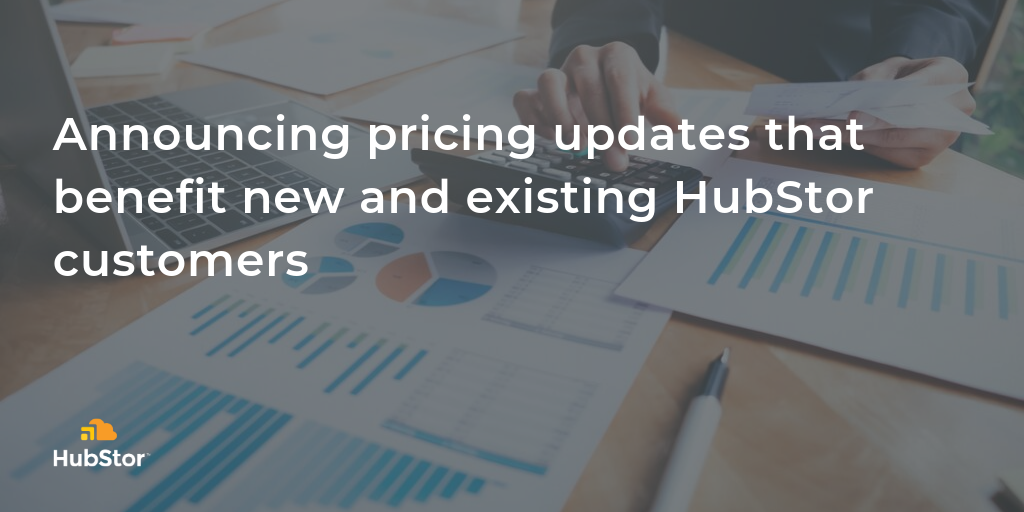I am happy to announce an improvement to HubStor’s consumption-based pricing model: We now exclude all storage operations and network egress costs from the HubStor markup calculation!
Existing HubStor customers will notice the difference starting in their October invoices. New customers deploying from this point forward will begin their HubStor subscription with this benefit in place by default.
How will this benefit customers?
There are three scenarios where you'll realize savings, as follows:
- Ingestion. By not marking up storage operations costs, you will not see large spikes when seeding workloads that have high object counts.
- Data retrieval involving network egress. Egress costs no longer have a HubStor markup applied, so large downloads will not significantly spike costs.
- Geo-replication and cloud backup involving network egress. By exempting both normal egress bandwith and geo-replication bandwidth, pricing for GRS, RA-GRS, or HubStor's cloud backup are significantly less.
Why are we removing storage operations and network egress fees from HubStor's pricing?
IT leaders love HubStor’s consumption pricing model because it offers full transparency, where you only pay for what you use. Additionally, you get an enterprise infrastructure software-as-a-service solution based purely on cloud infrastructure usage (instead of an added arbitrary concept like device or user license fees on top of the cloud pricing model).
But the one downside to the consumption markup model has been the activity costs that originate with the underlying cloud provider. We define activity costs as storage operations and network egress fees.
Before this change, when activity costs spiked as a result of seeding workloads with high object counts, for example, it had the effect of swelling the floating HubStor margin. While the long-term financial business case for HubStor was compelling, the activity costs with our additional margin often created a sticker shock effect with certain workloads.
We want HubStor to be your obvious choice for the secure storage of your unstructured data, no matter what workload you’re moving to the cloud.
By removing HubStor fees from the activity cost equation, we give our loyal customers an excellent reduction in their spend as they grow their footprint in HubStor while making it easier for new customers to get started.
What does this mean for HubStor billing?
I’ve never been a fan of storage operations and egress activity costs in the cloud. I’m sure I’m not alone in this because the activity costs of cloud storage are often confusing to people, and challenging to predict with accuracy.
For greater clarity, whether you host HubStor in your account or under HubStor’s account, you will still incur the cloud provider’s activity costs. It’s not within our capacity to convince the major cloud providers to amortize cloud activity costs into their storage fees.
However, it is within our control to improve the HubStor pricing model. HubStor’s margin calculation now exempts storage operations and network egress fees from the calculation, giving you a significantly lower HubStor invoice when these cost elements are significant.
Before-and-after comparison of HubStor’s pricing
For this example, let’s assume a baseline of 100 terabytes of data with an average object size of 300 KB, representing 350 million objects seeding to a blend of hot, cool, and archive storage tiers. We’ll also assume 1 TB monthly data growth and 500 GB of monthly egress bandwidth.
In the old model, HubStor consumption pricing would look something like this:

Notice the spike in costs within the first four months. This is due to the storage operations costs associated with writing, validating, tiering, and indexing 350 million objects.
In the new model, using the same assumptions, HubStor’s pricing now looks like this:
 You can see that the underlying cloud costs are still spiking in the first four months due to storage operations. However, you can also see that HubStor’s floating margin no longer inflates due to activity cost spikes, working to contain the fully-loaded price.
You can see that the underlying cloud costs are still spiking in the first four months due to storage operations. However, you can also see that HubStor’s floating margin no longer inflates due to activity cost spikes, working to contain the fully-loaded price.
Connect with us for any questions
I’m confident that HubStor’s consumption model is the future of software-as-a-service pricing for enterprise infrastructure solutions, and the team at HubStor is excited about this improvement.
We can help you model your cloud storage spend and accurately depict your cost profile month to month over multiple years. Get in touch today to speak with our team.


